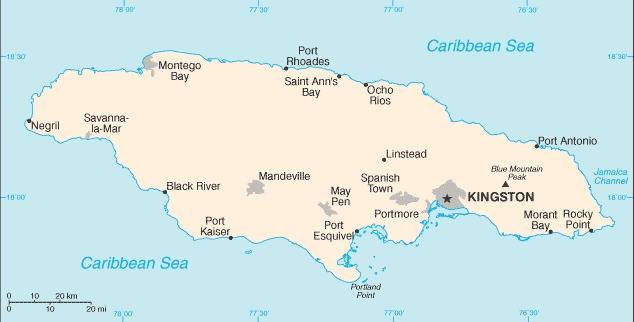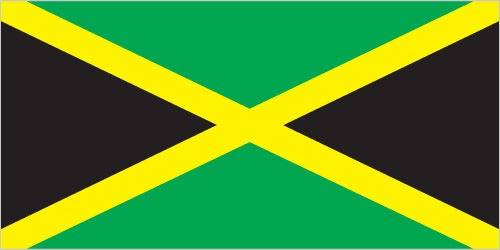Diagonal yellow cross divides the flag into four triangles – green (top and bottom) and black (hoist side and fly side). Green represents hope, vegetation, and agriculture, black reflects hardships overcome and to be faced, and yellow recalls golden sunshine and the island’s natural resources.
Flag courtesy of the CIA World Factbook

Map courtesy CIA World Factbook
Google Earth

Jamaican Curry Goat with rice and peas.
Photo courtesy of the CIA World Factbook
Jamaica is a member of
ICAO and
JARUS.
Last updated on March 11, 2025
Government
According to Britannica, under the Jamaica (Constitution) Order in Council of 1962, by which the island achieved independence from the United Kingdom, Jamaica is a constitutional monarchy with a parliamentary system of government. Citizens at least 18 years of age are eligible to vote. Jamaica has had universal suffrage since 1944.
The prime minister, who is head of government, is appointed by the leading political party from its parliamentary members. The British monarch, who is titular head of state, follows the prime minister’s recommendation in appointing a Jamaican governor-general who has largely ceremonial powers. The principal policy-making body is the cabinet, which consists of the prime minister and at least 11 other ministers.
The bicameral parliament consists of the House of Representatives and the Senate. The House has 63 members, who are directly elected. The speaker and deputy speaker are elected by the House from its members. The Senate has 21 members, who are appointed by the governor-general—13 in accordance with the advice of the prime minister and eight on the advice of the leader of the opposition party. Senators are appointed for the duration of a single parliamentary term. The president and deputy president of the Senate are elected by its members. General elections must be held at least once every five years, and the governing party may choose to hold early elections.
The legal system is based on English common law. The highest court in the Jamaican legal system is the Court of Appeals. It hears appeals from the Resident Magistrates’ Courts, which include the Family Courts, the Kingston Traffic Court, Juvenile Courts, and a division of the Gun Court. The Court of Appeals also handles appeals from the Supreme Court, the country’s highest trial court. The governor-general, on the advice of a Jamaican Privy Council, may grant clemency in cases involving the death penalty; occasionally such cases are referred to the Privy Council of the United Kingdom. According to human rights organizations, the judicial system is overburdened, with long delays before trials and with prison conditions characterized by overcrowding, insufficient food supplies and funding, and occasional brutality.
The island is divided into 14 parishes, two of which are amalgamated as the Kingston and St. Andrew Corporation, generally corresponding to the Kingston metropolitan area. Parish councils, whose members are directly elected, administer the other parishes. The capitals of some parishes have elected mayors. Jamaica is also traditionally divided into three counties, Cornwall, Middlesex, and Surrey.
Jamaica Civil Aviation Authority (JCAA)
On April 1, 1947, Jamaica established the Civil Aviation Department (CAD). Its purpose was to ensure the compliance of all air operators with international and local rules and regulations. The main objective was to ensure the safe and expeditious flow of air traffic within Jamaica’s airspace. The need to transform the CAD from a Civil Service agency to a statutory entity was necessary for modernizing the Department and keeping apace with the growth of civil aviation locally and worldwide. The Jamaica Civil Aviation Authority (JCAA) was, therefore, established by the Civil Aviation (Amendment) Act 1995. The Authority became operational on May 6, 1996.
Airspace
SkyVector – Google Maps – ADS-B Exchange
ICAO countries publish an Aeronautical Information Publication (AIP). This document is divided into three parts: General (GEN), En Route (ENR) and Aerodromes (AD). ENR 1.4 details the types of airspace classes they chose to adopt from classes A through G.
Jamaica AIP (to view you need to create a user name and password)
Drone Regulations
Drone Laws
Includes rules for:
Recreational UA operators or Hobbyists – Persons who operate model aircraft or UAs for recreational purposes.
Professional (commercial & non-commercial) operators – persons or companies which operate UAs for non-recreational purposes, including business-related activities such as, but not limited to, aerial photography, surveillance, geometric surveys, power line inspections, crop observations and research and development. Note that the latter require Special Aerial Work Permits, which are granted by the JCAA, subject to the operator/s meeting specific criteria.
FSN-GN-2015-01:R3 Operations of Unmanned Aircraft to learn more about the Flight Safety Notification for UA Operators.
Advanced Air Mobility (AAM) Regulations & Policies
None found by the author.
However, should you, the reader, happen to stumble across something to the contrary, please email the author at FISHE5CA@erau.edu and you may be mentioned in the ACKNOWLEDGEMENTS section of this book by way of thanks for contributing to this free eBook!
Advanced Air Mobility (AAM) News
None found by the author.
However, should you, the reader, happen to stumble across something to the contrary, please email the author at FISHE5CA@erau.edu and you may be mentioned in the ACKNOWLEDGEMENTS section of this book by way of thanks for contributing to this free eBook!
Short Essay Questions
You have been hired by a Drone Startup Company. Your boss has immediately assigned this job to you.
They need you to prepare a one-page memo detailing the legalities of using a drone in Jamaica.
They need you to mention any national laws and local ordinances.
They specifically want to know what airspace (insert pictures) you will be operating in and whether or not you need an airspace authorization.
Does it matter whether or not you are a citizen of the country?
Lastly, there is a bonus for you if, as you scroll through this chapter, you find any typos or broken links!
- What are the drone categories?
- How is registration addressed?
- How is remote ID addressed?
- What are the model aircraft rules?
- What are the commercial drone rules?
- Are there waivers or exemptions to the rules? If so, for what?
- Would you share a link to an interactive airspace map?
- How is BVLOS addressed?
- How can you fly drones at night?
- How can you fly drones over people?
- Where do you find drone NOTAMs?
- What are the rules for drone maintenance?
- What are the rules for an SMS program?
- What are some unique rules not mentioned above?
- What are the C-UAS rules?
- What are the AAM rules?




